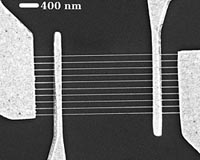 |
New York NY (SPX) Aug 03, 2009 At first glance, the light-emitting diode, or LED, beats the venerable incandescent bulb in every way. It's compact, bright, long-lasting, and in its latest form it can produce a warm, white light. Best of all, it saves more than enough money on electricity to cover the extra cost. But the LED is bedeviled by a problem known as droop, which kicks in just as the power levels begin to get high enough for general lighting. At that point, the efficient device turns wasteful, and to get a little more light you have to put in a lot more power, kissing the extra efficiency good-bye. Nobody can yet explain droop, at least in a way that everyone else accepts. In the August issue of IEEE Spectrum, Richard Stevenson, a Wales-based physicist turned science writer, reviews the theories on droop and describes how scientists are finding ways to mitigate the problem--even without fully understanding it. Stevenson describes in clear terms exactly how an LED is made; how the modern blue-emitting ones, based on nitrides, differ from the older design; where in the semiconducting device the problem is believed to strike; and what's been done to redesign that region. One group of scientists, led by the famous inventor of the blue, nitride LED, Shuji Nakamura, began their reasoning with the observation that LEDs turn electricity into light by allowing electrons to recombine with their doppelgangers, positively charged "virtual" particles known as holes, to produce photons, or particles of light. The scientists argue that recombination takes place in certain apparent defects that in fact are necessary for the functioning of the device. They conclude that the limited number of defects puts a cap on how much power the LED can use efficiently--and thus explains droop. Another group of scientists believes that some of the electrons and holes leak out of the place they're supposed to be, and that this leakage prevents recombination. Still another group asserts that the problem is in the inefficiency of the recombination process itself, which in certain cases yields not photons but phonons--virtual "particles" of sound that drain the energy away uselessly. Meanwhile, as theorists squabble, practitioners have been making progress. Philips Lumileds Lighting Co. claims that it has conquered droop with a device based on specially engineered structures that increase the rate at which electrons and holes recombine. E. Fred Schubert at the Rensselaer Polytechnic Institute, together with Korea's Samsung Electro-Mechanics Co., have annnounced that they have made progress by following a different strategy. Hardly a month goes by without new developments in this technology, which is critical to the multibillion-dollar lighting industry. Someday, in our lifetimes, incandescent filaments will finally stop turning tens of gigawatts into unwanted heat. Smokestacks will spew less carbon into the global greenhouse. And we won't have to get up on stepladders to change burned-out bulbs nearly as often as we do today. And by the time we're all reading by the light of LED lamps, maybe we'll even know how our newfangled devices work. Maybe we'll know the answer to the burning question that remains: What causes droop? Share This Article With Planet Earth
Related Links IEEE Spectrum Magazine Powering The World in the 21st Century at Energy-Daily.com
 Graphene Has High Current Capacity, Thermal Conductivity
Graphene Has High Current Capacity, Thermal ConductivityAtlanta GA (SPX) Aug 03, 2009 Recent research into the properties of graphene nanoribbons provides two new reasons for using the material as interconnects in future computer chips. In widths as narrow as 16 nanometers, graphene has a current carrying capacity approximately a thousand times greater than copper - while providing improved thermal conductivity. The current-carrying and heat-transfer measurements were ... read more |
|
| The content herein, unless otherwise known to be public domain, are Copyright 1995-2009 - SpaceDaily. AFP and UPI Wire Stories are copyright Agence France-Presse and United Press International. ESA Portal Reports are copyright European Space Agency. All NASA sourced material is public domain. Additional copyrights may apply in whole or part to other bona fide parties. Advertising does not imply endorsement,agreement or approval of any opinions, statements or information provided by SpaceDaily on any Web page published or hosted by SpaceDaily. Privacy Statement |